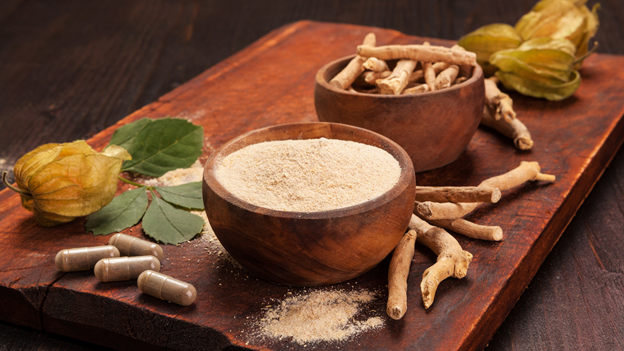For thousands of years, Ashwagandha has been used as herbal medicine because of its multiple health benefits. Like other medicinal herbs, it is one of the most important Ayurveda herbs to treat a wide range of medical conditions.
What is ashwagandha?

An evergreen shrub – Ashwagandha (Withania somnifera), is an Ayurveda medicine that is widely grown in the Indian region, the Middle East, and different regions of Africa. It is commonly known as “Winter cherry.” The ashwagandha plant has red berries having medicinal properties like its roots.
Ashwagandha is also called Indian ginseng because it produces similar benefits to the Chinese medicine ginseng. Despite the structural similarity of active phytochemicals found in the roots, ginseng and ashwagandha plant are not botanically related.
It belongs to adaptogens that can support mental and physical health by reducing stress and improving energy conservation.
Parts of Ashwagandha plant
Roots
The ashwagandha plant roots act as a stimulant, thermogenic, astringent, anthelmintic, diuretic, narcotic, and tonic. It is called ashwagandha because of the horse-like smell of its roots.
The ashwagandha roots have many benefits, such as thyroid problems like goiter, constipation, nervous breakdown, constipation, and insomnia.
The formation of paste with crushed roots and water helps bring a significant reduction in inflammation at the joints. When combined with other drugs, Ashwagandha roots can be to treat scorpion sting as well as snake venom.
Leaves
The ashwagandha plant leaves are bitter, but they are recommended to be used for painful swellings and fever.
Flowers
The ashwagandha flowers are depurative, which means to have a purifying and detoxifying effect. Similarly, flowers can be used as diuretics and have a libido-boosting effect.
Seeds
The seeds of ashwagandha tend to be used as anthelmintic, i.e., the ability to destroy parasitic worms.
Uses of Ashwagandha
Being an important herb in India’s traditional medicinal system, Ashwagandha serves as part of one of the oldest medicinal systems and healthcare systems of India.
In Ayurveda medicine, ashwagandha is regarded as Rasayana, which means assisting in maintaining physical and mental health.
The herb is also known to produce anti-inflammatory and neuroprotective effects. However, inflammation can be due to various reasons.
The protective use of ashwagandha helps in the treatment of the following conditions:
- Stress and anxiety
- Pain
- Skin condition
- Fatigue
- Diabetes
- Epilepsy and
- Arthritis
The treatment of the wide-ranging medical conditions is primarily based on the use of different parts of the plant, including root, berries, seeds, etc.
Additionally, ashwagandha has gained more popularity in the West region and can be bought as a supplement.
Health benefits of Ashwagandha
Scientific studies have reported different benefits of ashwagandha; some of the benefits are as follows:
Stress and anxiety

Ashwagandha gives a calming effect to relieve the symptoms of anxiety compared to the drug lorazepam, which is a medication mainly used for anxiety and sedation.
As suggested by a 2000 study, ashwagandha represented a comparable effect of reducing anxiety compared with lorazepam. This study showed that ashwagandha tends to be highly effective in reducing anxiety.
According to a human trial reported in Medicine, the intake of 240gm of ashwagandha as the daily dose showed a significant reduction in the stress levels compared to placebo. The reduction in the stress level was reduced in the release of the stress hormone – cortisol.
In a 2019 study, a randomized human trial was conducted to examine ashwagandha’s effect at the dose of 250mg and 600mg per day. This resulted in lower levels of cortisol and stress levels.
However, such evidence regarding the anti-depressant effect of ashwagandha is promising, still more research needs to be conducted to recommend the treatment of anxiety.
Arthritis:
Considering ashwagandha to act as a pain reliever helps prevent pain signals from traveling to the central nervous system to respond against them. Also, it has anti-inflammatory properties.
According to a 2015 study in the Indian Journal of Medical Research, the study participants were patients with rheumatoid arthritis, and treating the condition with ashwagandha showed the potential of treatment.
Thus, the use of ashwagandha powder is considered effective in treating arthritis which mainly includes rheumatoid arthritis. But, there is a need to conduct more research for the confirmation of the findings.
Brain conditions:
Scientific studies have proposed that ashwagandha can slow down, stop or reverse the damage of nerve cells. If the conditions are left untreated, it might lead to nervous system issues like Parkinson’s, Alzheimer’s, and Huntington’s disease.
According to a review in the African Journal of Traditional, Complementary, and Alternative Medicines, studies have shown upon examination of ashwagandha that it can slow down and help prevent loss of brain function in patients suffering from neurodegenerative conditions.
With the progression of degenerative conditions, brain parts and connective paths are prone to damage, leading to brain function loss and memory loss. Thus, the trials on rats and mice have demonstrated the potential to use ashwagandha to protect brain cells.
How does it work?
The effects of ashwagandha vary and are dependent on the dosage of the product.
The structure of ashwagandha includes either withanolide glycosides or steroidal lactones. The technical classification is not of much importance, but these structures tend to represent unique functions like:
Withanolide A helps inhibit acetylcholinesterase and acts as a cortisol suppressant, immunosuppressant, and immunostimulant.
Sominone – is known to promote the length of axon and neurogenesis.
Withaferin A – has a cytotoxic effect.
Aswagandhanolide – produces an inhibitory effect on different cancer types.
Withanone – is known for promoting cell apoptosis in the cancer cells of the breast.
Withanosidehelps reduce the anxiety and stress level and brings improvement in the neurogenesis and axon length.
Each of the withanolides produces the ashwagandha effect, and these compounds are highly active in different parts of the plant. So, it is important to look for the regions with many such components for extraction.
Thus, ashwagandha’s root extracts have been standardized to be used as they provide numerous health benefits.
Forms of ashwagandha:
When it is about the consumption of this herb to gain therapeutic benefits, its root and berry are used to create different forms for ingestion. Upon ingestion, it provides many benefits like improvement in sleep quality, management of anxiety and depression, strengthening of the immune system, and stress relief.
Capsule
Ashwagandha capsules are one of the safest ways to take them as a supplement. Ashwagandha capsules are beneficial for both men and women in different ways as it turns out to be the easiest way to get enough ashwagandha dose.
Ashwagandha with black pepper enhances the properties of strengthening the immune system, reduces stress levels, treats hormonal imbalance, improves energy levels that serve as a mood booster, and other properties.
According to a 2019 study, about 60 patients were provided with root extracts of ashwagandha in capsules with water and milk twice a day. The medication was well-tolerated and brought significant improvement in the quality of sleep and other parameters associated with anxiety and insomnia.
The standardized dose of ashwagandha in the form of a capsule is recommended to be 500-1500mg capsules one to two times a day based on the need.
Powder

The ashwagandha powder for consumption should be extracted from its roots. In the Indian region, the powder form of ashwagandha is known as ashwagandha churna.
According to a 2012 study, ashwagandha churna showed significant improvement in the somatic complaints, including hot flushes, white discharge, and GIT disturbances.
The intake of ashwagandha powder is recommended with milk as it is known to calm the body’s nervous system.
Taking ashwagandha powder with milk ensures better sleep and helps in waking up well-rested with boosted energy levels. It can also be taken at the start of the day to give your long day an improved experience.
Vegan can take ashwagandha powder safely with water.
Liquid Extract
In a 2015 study, the liquid extract was used to treat autoimmune inflammatory disorder – rheumatoid arthritis. The intake of ashwagandha aqueous extract to a maximum of 300mg/day showed a significant reduction by exhibiting anti-arthritic activity and antioxidant activity, suggesting it to be used to treat arthritis.
In another study reported in the Journal of Ayurveda and Integrative medicine, root extracts of ashwagandha were given to the study participants of dose 250mg per day. After 12 weeks, the aqueous extract of ashwagandha showed a better response by reducing the knee joint pain than the placebo effect.
Roots extracts of the ashwagandha plant are recommended because they contain high levels of Withaferin A as it has cytotoxic effects that result in the killing of cancer cells.
Liquid extract of ashwagandha root can be taken by boiling ¼ to ½ teaspoon of ashwagandha root powder in two cups of water. You can also add honey and ginger to add taste to the tea.
How to identify ashwagandha?
The appearance of the root powder of ashwagandha is from light brown to medium brown. The texture of ashwagandha powder is soft and fine, having small-sized particles, which makes it fluffy. In the form of capsules, taking 500mg of organic ashwagandha is safe in combination with other ingredients.
The ashwagandha capsules can be found in vegetarian capsules as well for vegetarian people. Make sure to check the label of the product if it contains organic ashwagandha root powder.
Risks:
- Pregnant women should not consume ashwagandha powder.
- Breastfeeding women are not recommended to take ashwagandha powder.
- If you are on medication, consult your doctor before taking ashwagandha supplements.
- Stop use of ashwagandha before two weeks of surgery.
- Avoid intake of large doses to reduce the risk of vomiting, diarrhea, and upset stomach.
The Bottom Line:
Despite the presence of different forms of ashwagandha, choosing the right form is of great importance. However, each form of ashwagandha gives the same kind of benefits, but they might also result in harmful effects that would negatively influence the individual’s health.
Among all the forms of ashwagandha that are commercially available, the best of ashwagandha is a capsule. Because it is a widely used form and easy to consume. In research studies, the use of root powder of ashwagandha and its extract was in a capsule form.
FAQs:
Can ashwagandha cause nausea and vomiting?
If ashwagandha is taken in high doses, it can cause nausea, vomiting, and other conditions like diarrhea and stomach upsets. These side-effects are well-tolerated, and it is recommended to limit the intake according to the standardized dosage that is a maximum of 1500mg per day.
Can I take Ashwagandha on an empty stomach?
Yes,you can take ashwagandha on an empty stomach as the first thing to start a good and energized day. It is effective to be taken early morning in tea or powder as a churna ball. Consult your doctor before increasing the recommended dosage.
What is the best time to take Ashwagandha?
You can take ashwagandha at any time you feel comfortable taking it. The intake of ashwagandha is dependent on your needs and requirements. For instance, to improve sleep quality, you can take ashwagandha before going to bed or after your last meal of the day. Similarly, to energize your body, you can take it in the morning as well.
How long does Ashwagandha take to work?
Considering the recommended dose of ashwagandha per day, i.e., 500mg, the effects can be seen after the first month of use. The result of ashwagandha might vary based on the need of an individual. If you live a healthy lifestyle, you might be able to observe results in around two weeks. The results also vary depending on the quality of the product consumed.





